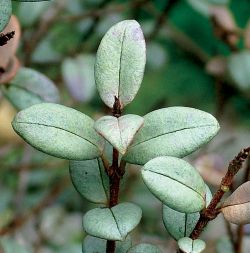Plant
Doctor Archive
Invasion
of thrips
  SEVERAL
years ago a landscaper planted a hedge of Chilean cranberry in my
garden. It grew well at first though didn't produce much fruit.
But now all the leaves have turned silvery and it seems to be dying
back in places. A few green shoots appear at times, but they eventually
turn silvery too. Any tips? SEVERAL
years ago a landscaper planted a hedge of Chilean cranberry in my
garden. It grew well at first though didn't produce much fruit.
But now all the leaves have turned silvery and it seems to be dying
back in places. A few green shoots appear at times, but they eventually
turn silvery too. Any tips?
 YOUR
Chilean cranberry (Ugni molinae, sometimes sold as Myrtus
ugni) is suffering from a severe invasion of thrips. YOUR
Chilean cranberry (Ugni molinae, sometimes sold as Myrtus
ugni) is suffering from a severe invasion of thrips.
These tiny pests live
on the undersides of the leaves and feed by rasping at the cell
walls and sucking out their contents. If you look underneath a leaf
you may see dark tar-like blobs - these are thrips' droppings, which
are almost as large as the pests themselves.
Adult thrips are usually
black, about 1-2mm long and very narrow in shape. Young thrips are
even smaller and tend to be yellowish or honey-coloured.
You can spray to control
them, but your cranberries are so infested I recommend you prune
them right back to within 10cm or so of the ground. Burn the prunings
or put them out with the rubbish. Water the plants well and feed
with a general fertiliser to encourage fresh clean growth.
There's obviously a
source of thrips in your neighbourhood, so you'll need to try to
prevent them invading the new growth. Keep the plants well watered
and spray water over the plants, as thrips don't thrive in damp,
humid conditions. At the first sign of damage (silvering of some
leaves) you could spray with an organic pyrethrum-based insecticide
such as Garlic & Pyrethrum or Nature's Way Pyrethrum, but you'll
need to make sure you get good spray coverage under the leaves.
Or use a systemic insecticide like Confidor or Rogor 100 which is
translocated through the leaves. Make sure you read and follow the
label instructions, particularly with regard to withholding periods
if you get some fruit next season.
Weekend
Gardener, Issue 144, 2004, Page 26
Reproduced with permission from the former Weekend Gardener magazine. The views expressed here are not necessarily those of the RNZIH.
|
 |
 |
|